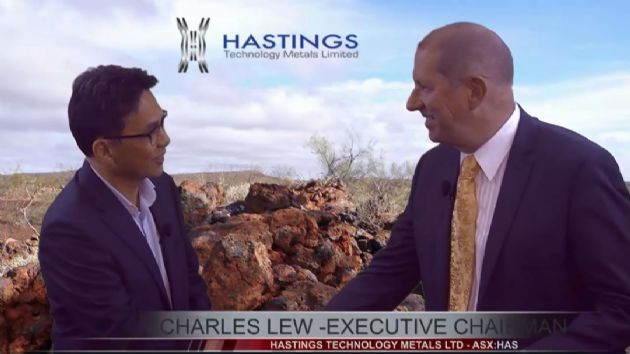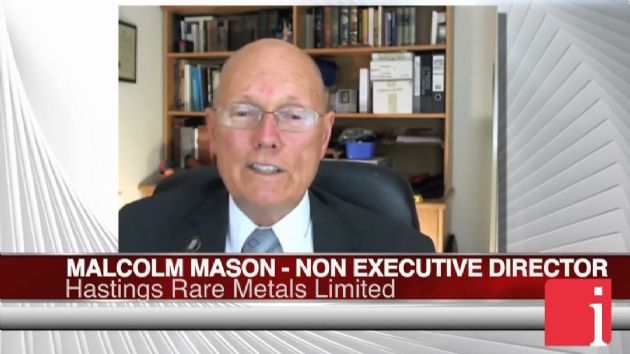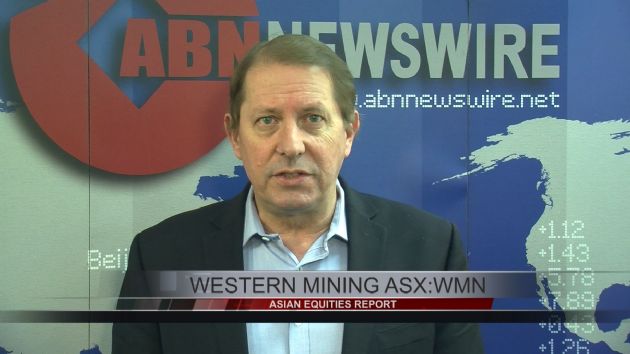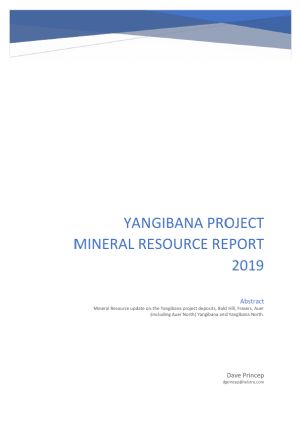
Ore Sorting Testwork Results 26% Uplift in Mine Head Grade
Perth, Aug 18, 2021 AEST (ABN Newswire) - Australia's next rare earths producer, Hastings Technology Metals Ltd ( ASX:HAS) (
ASX:HAS) ( 5AM:FRA) is pleased to announce that ore sorting test work on samples sourced across the Yangibana Rare Earths Project (Yangibana), in Western Australia's Gascoyne region, has confirmed its suitability within the beneficiation process, delivering early gangue mineral rejection and a significant upgrade of rare earths material prior to the higher-cost processing steps.
5AM:FRA) is pleased to announce that ore sorting test work on samples sourced across the Yangibana Rare Earths Project (Yangibana), in Western Australia's Gascoyne region, has confirmed its suitability within the beneficiation process, delivering early gangue mineral rejection and a significant upgrade of rare earths material prior to the higher-cost processing steps.
The ore sorting test results confirmed that the total rare earths oxide (TREO) recovery through the ore sorter is a linear function, where the lower the head grade the higher the mass rejection becomes. It is therefore forecast, based on the average content of alumina and silica for all Yangibana deposits, that 24% of the proposed crusher feed will be rejected by the ore sorters as waste at the expense of only 4% TREO volumes across the life of mine (LOM) schedule.
The variability test work program was completed testing 12 samples from across the Yangibana deposits. The performance of the ore sorters is closely linked to head grade, resulting in LOM mass rejection of 24% with a corresponding increase in average grade of TREO content of 26%.
Commenting on the ore sorter test work, Hastings Technology Metals Chief Operating Officer Andrew Reid said: "These results are enormously satisfying and exceeded all our expectations - the introduction of ore sorting has removed waste or very low-grade material to deliver a significant overall improvement in the mine head grade that will be put through the more advanced stages of Yangibana's process flow sheet. "This, in turn, has the potential to reduce Yangibana's processing operating costs and further enhance the value of the industry high levels of neodymium and praseodymium (NdPr) contained in our ore bodies. "Importantly, the rejection of the waste or very low-grade material at the front end of the process has had almost no impact on Yangibana's LOM, underpinning the potential win-win of adding the ore sorter to the overall process flow sheet. "Hastings will now progress the detailed design for an ore sorting system that can process 100% of Yangibana's LOM mine feed material."
Initial bulk test work was completed in 2019 (see ASX announcement dated 25 November 2019 Bulk Ore Sorting Trial Shows Outstanding Results). This test work program assessed various sorting sensors on small-scale samples and optimisation of the set-up for the XRT sensors on a bulk sample.
A more extensive ore sorting variability test program has now been completed on drill core obtained from the proposed pit areas of Bald Hill, Simon's Find, Frasers, Yangibana, Yangibana North-West and Auer. The drill core samples were crushed, screened and sorted using an XRT ore sorter. The sorted samples and their corresponding unsorted samples were then tested in separate batch flotation bench tests at ALS laboratories in Perth. A total of 12 samples was tested through the sorting and flotation phase. In addition, two sets of composite samples were tested through the flotation stages of the process flow sheet.
Flotation results on the 12 samples confirmed that the sum of the sorted samples made a rare earths concentrate 7% higher in Nd2O3+Pr6O11 recovery and 1% higher in Nd2O3+Pr6O11 grade compared with the sum of the corresponding unsorted samples.
Four composite samples (two sorted; two unsorted) were made from the sorted and their corresponding unsorted samples to simulate a blended crusher feed stock from Simon's Find and a blended crusher feed stock from Bald Hill. Compared with unsorted composite samples, the sorted samples delivered a much higher Nd2O3+Pr6O11 recovery (Table 1 and Table 2*).
The results of the ore sorting variability test work demonstrate that the ore sorter excels at both creating high-grade products for this material as well as maintaining high recoveries with significant mass reduction, relative to the amount of non-ironstone dilution included in the feed sample.
*To view tables and figures, please visit:
https://abnnewswire.net/lnk/EV2L4W6C
About Hastings Technology Metals Ltd
 Hastings Technology Metals Ltd (ASX:HAS) (FRA:5AM) is advancing its Yangibana Rare Earths Project in the Upper Gascoyne Region of Western Australia towards production. The proposed beneficiation and hydro metallurgy processing plant will treat rare earths deposits, predominantly monazite, hosting high neodymium and praseodymium contents to produce a mixed rare earths carbonate that will be further refined into individual rare earth oxides at processing plants overseas.
Hastings Technology Metals Ltd (ASX:HAS) (FRA:5AM) is advancing its Yangibana Rare Earths Project in the Upper Gascoyne Region of Western Australia towards production. The proposed beneficiation and hydro metallurgy processing plant will treat rare earths deposits, predominantly monazite, hosting high neodymium and praseodymium contents to produce a mixed rare earths carbonate that will be further refined into individual rare earth oxides at processing plants overseas.
Neodymium and praseodymium are vital components in the manufacture of permanent magnets which is used in a wide and expanding range of advanced and high-tech products including electric vehicles, wind turbines, robotics, medical applications and others. Hastings aims to become the next significant producer of neodymium and praseodymium outside of China.
Hastings holds 100% interest in the most significant deposits within the overall project, and 70% interest in additional deposits that will be developed at a later date, all held under Mining Leases. Numerous prospects have been identified warranting detailed exploration to further extend the life of the project.
Brockman Project
The Brockman deposit, near Halls Creek in Western Australia, contains JORC Indicated and Inferred Mineral Resources, estimated using the guidelines of JORC Code (2012 Edition).
The Company is also progressing a Mining Lease application over the Brockman Rare Earths and Rare Metals Project.
Hastings aims to capitalise on the strong demand for critical rare earths created by the expanding demand for new technology products.
| ||
|











